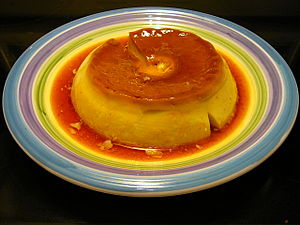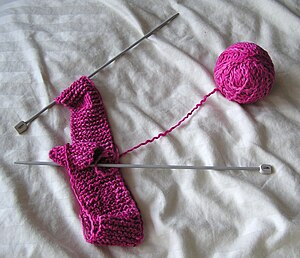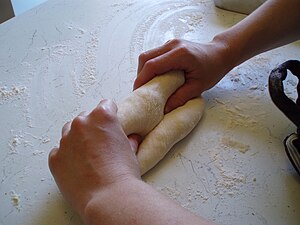 Homemade Flan (Photo credit: Wikipedia)Fridays were my favorite. I spent Fridays with my next-door neighbors, the Diegos. Abuela Rosa was originally from Puerto Rico. She was round, soft, and cheerful; she loved to laugh and sing and rumba. Friday night was always a fiesta. Family came to eat from Abuela’s abundant table, and then they’d push the furniture aside for music, and dancing. My Spanish became fluid, if not fluent, under their instruction.
Homemade Flan (Photo credit: Wikipedia)Fridays were my favorite. I spent Fridays with my next-door neighbors, the Diegos. Abuela Rosa was originally from Puerto Rico. She was round, soft, and cheerful; she loved to laugh and sing and rumba. Friday night was always a fiesta. Family came to eat from Abuela’s abundant table, and then they’d push the furniture aside for music, and dancing. My Spanish became fluid, if not fluent, under their instruction.While Abuela Rosa’s son, Javier, taught me to play the guitar and sing, her daughter taught me to dance the very sensual dances of Latin America. I felt naughty when I first learned to dance that way, with swaying hips and coquettish eyes, tempting the boys with my body. I soon loved it though. It made me feel womanly and powerful, to watch the boys watch my body tracing out the strains of the melody, my feet keeping pace with the beat.
Flan
This recipe is easy once you have the hang of it. If you mess up while you’re getting the hang of it, portion it into individual bowls and call it custard.
Preheat over to 350
 The first stage in making caramel is to start with a simple syrup by dissolving 2 parts sugar in 1 part water over medium heat. This image is from filtsai.com. A larger version can be obtained from http://www.filtsai.com/cooking/caramel/ (Photo credit: Wikipedia)
The first stage in making caramel is to start with a simple syrup by dissolving 2 parts sugar in 1 part water over medium heat. This image is from filtsai.com. A larger version can be obtained from http://www.filtsai.com/cooking/caramel/ (Photo credit: Wikipedia)Take a non-stick fry pan and coat the bottom with real sugar (about 1 cup). I like to use sugar only. It seems to work best for me -- it's the way I learned it from Abuela Rosa. Her sister Tia Karina insists that it comes out better when you put in 1 cup of sugar and 1/2 cup of water. You may want to experiment and see what works best for you. Put it on a medium heat and just let it sit. This will turn into caramel in about 15 minutes or so. The timing depends largely on the weather and humidity.
While you are waiting (without stirring!) for your sugar to melt, put 3 eggs in a mixing bowl and whip them until they are a soft pale yellow color.
By now your sugar is ready. You need a pie dish. Pour the liquid caramel quickly into a glass pie dish. If you are new to this: try warming your pie dish first in the oven. This will give you more time. Pour into the center and immediately - and I mean fast! - swirl your pie dish to coat the bottom. It will harden. Set this aside.
Now into the bowl with your 3 whipped eggs add:
A can of carnation milk (12 oz)
A can of sweet condensed milk (14 oz)
2 tsp vanilla
Stir this together to blend and pour it into your caramel covered pie dish.Bake this in a BAÑO DE MARIA. That means place a large pan in the oven (like a broiler pan), place the pie plate with egg mixture in the center, add water to the large pan so that it comes about half way up the pie plate. This allows the custard to cook gently and evenly.
Bake for 1 hour until the middle is set. Let the flan cool on a rack, then put into the fridge to thoroughly chill.
To serve: run a knife around the edges then put your serving plate on top. Holding it firmly, invert in one quick motion. Your caramel will be liquid again.
This is a beautiful desert. Abuela also used it to tempt sick tummies to eat a little something, or for breakfast…okay we liked it so much we looked for excuses to make it and eat it! Good thing I jog.











